Blues is individualistic and expressive as a musical style, heavily emphasizing improvisation, much like jazz. Despite that, you’ll notice some recurring elements in countless blues tunes, such as the 12-bar form, extended chords, and the ubiquitous I – IV – V sequence.
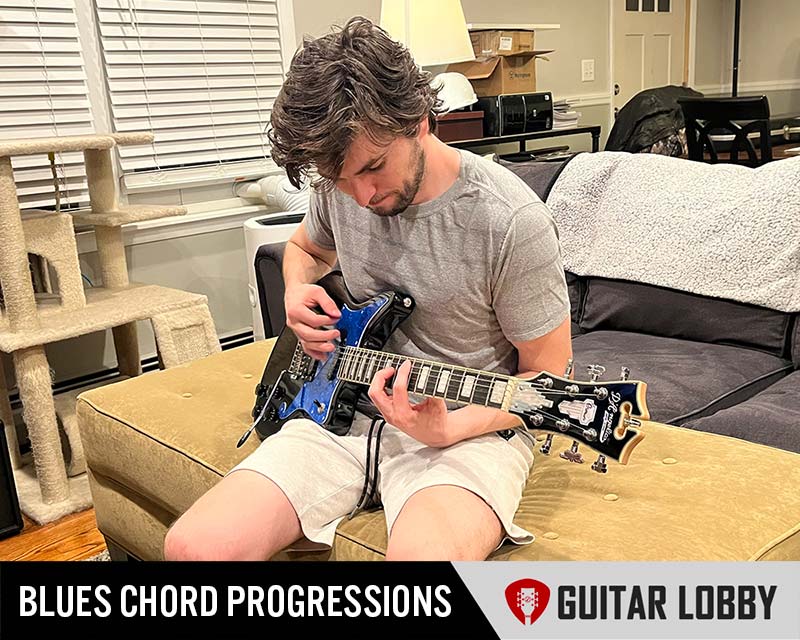
In this guide, I’ll walk you through not only the ultra-popular I – IV – V chord pattern but several other common blues chord progressions.
Chord Progressions Every Aspiring Blues Guitarist Should Know About
Blues can be recognized by emotive lyrics, call-and-response patterns, syncopated rhythm, and, last but not least – short, repetitive chord progressions. Here are 15 chord sequences that’ll give you a rock-solid grounding in blues comping.
Table of Contents
1. I – IV – V
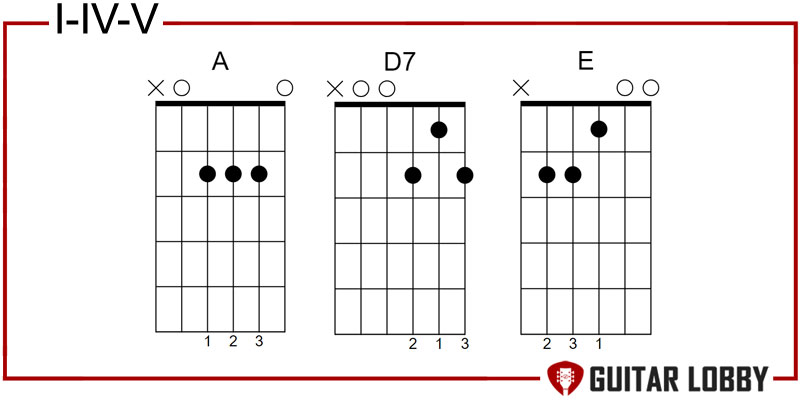
Think of the I, IV, and V chords as the fodder that fuels most blues chord progressions. They are by far the most important chords in this genre, with 8-, 12-, 16- and 24-bar long progressions built around them. The I or the tonic chord tells us the home key. The IV functions as subdominant, making listeners feel the tension of moving away from their home base. The V, or the dominant chord, is where the tension is at its highest, making the resolution to the tonic chord that much sweeter.
In the key of A major, the I – IV – V progression would be A major – D major – E major. But you’ll rarely see blues musicians or songwriters using I, IV, and V in their standard chord voicings. This brings us to dominant 7th chords. Without getting too much into music theory, a dominant 7th is a major chord that contains all the notes of a major triad along with a minor 7th note.
Because the minor 7th is a half step lower than the major 7th, whenever a dominant 7th is played, it gives off a sense of dissonance and tension. In other words, the classic bluesy vibe. In “Crossroads,” the enormously talented supergroup Cream uses A, D7, and E chords in a I – IV7 – V pattern. Here, the D7 chord (D, F#, A, C) is a dominant 7th consisting of a D major triad (D, F#, A) along with a minor or a flattened 7th note (C).
Popular Songs That Use This Progression: “Sweet Home Chicago” (Buddy Guy), “Crossroads” (Cream/Robert Johnson), “Hoochie Coochie Man” (Muddy Waters).
2. I7 – IV7 – V7
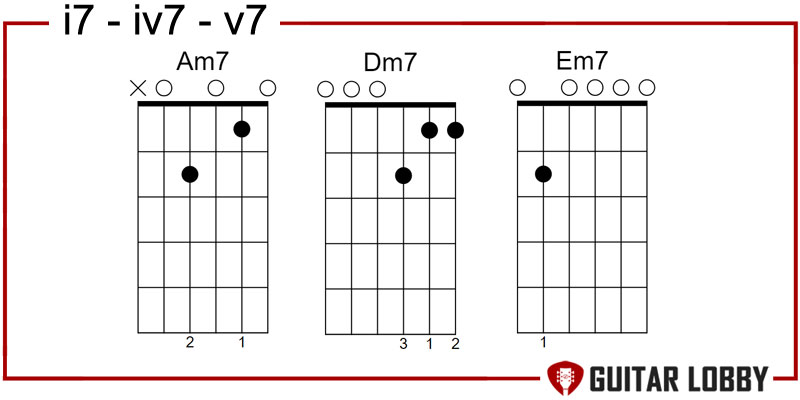
In “Crossroads,” Eric Clapton used a subdominant 7th chord. But you can turn any of the three major chords or, better still, all of them to get that bluesy vibe going. A I7 – IV7 – V7 pattern would pack a bluesy flavor from the word go. The four-note chords change the tonality dramatically, taking the happy-sounding major chords towards dissonance. When the progression finally resolves, it returns to a 7th chord, which keeps the sense of urgency constant.
These three chords are the building blocks of longer blues progressions that I’ll be talking about later in this list. The chords will more or less remain the same. It’s the order and how many bars you’ll play each chord that varies. In the E major key, this progression in its simplest form will look like E7 – A7 – B7. Play these chords with 7th notes and then without the additional notes. When you play them as regular major chords, the blues element we are all familiar with will be lacking.
Popular Songs That Use This Progression: “Everyday I Have Blues” (B.B. King), ” Damn Right I’ve Got the Blues” (Buddy Guy), “I Can’t Quit You Baby” (Willie Dixon).
3. I – ii
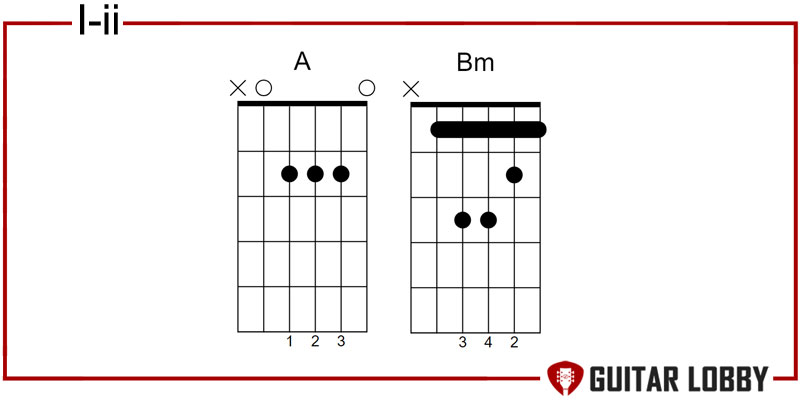
As surprising as it may seem, there are quite a few blues standards that use just two chords. The best example of this that springs to mind is Etta James’ heartbreaking vocal masterpiece “I’d Rather Go Blind.” The tonic, A major, and supertonic, B minor chords faithfully accompany James’ captivating vocals from start to finish.
Why it works so well is the absence of supertonic moving or resolving to a V or dominant chord. The quick movements associated with a 6/8 time signature and a walking bass keep things from getting monotonous in this two-and-a-half-minute-long ballad.
More recently, it’s Chris Stapleton’s jazz blues hit “Tennessee Whiskey” that makes brilliant use of these two chords. However, unlike “I’d Rather Go Blind,” “Tennessee Whiskey” uses the I – ii chord sequence as a part of a larger progression.
Popular Songs That Use This Progression: “I’d Rather Go Blind” (Etta James) “Tennessee Whiskey” (Chris Stapleton).
4. i7 – iv7 – i7 – VI7 – V7 – i7
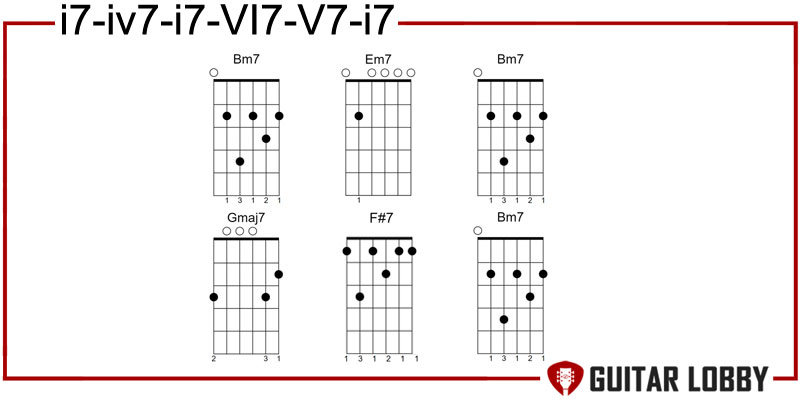
Whenever I hear the word “blues,” B.B. King is the first name that springs to mind. The man braved through tough times to become the ‘King of Blues.’ As a pioneer in the modern blues movement, King used his technical prowess, genre-bending songwriting, and imaginative guitar playing to turn standard three-chord blues into jaw-dropping masterpieces. One of his best-loved tunes, “Thrill is Gone,” is a minor blues standard built using chords from the B minor scale. Here are all the chords you’ll find in the key of B minor:
i = Bm ii° = C# dim III = D iv = Em v = F#m VI = G VII = A
If we apply the i7 – iv7 – i7 – VI7 – V7 – i7 pattern to this key, our progression should ideally look like Bm7 – Em7 – Bm7 – G7 – F#m7 – Bm7. But that’s not how King plays the tune. He employs a Gmaj7 instead of a G7 and an F#7 in place of F#m7. So when you get down to learning this song, this is the main chord sequence you’ll be dealing with:
Bm7 – Em7 – Bm7 – Gmaj7 – F#7 – Bm7
As far as Gmaj7 goes, this is just your standard G major chord with a major 7th. The F#7, however, has been borrowed by the B harmonic minor scale to create a V7 – I cadence. Replacing the v chord with a V7 chord is quite common in minor key progressions as it helps give listeners a more powerful resolution.
King plays this progression as a variation of the traditional 12-bar blues. He adds a turnaround in the last bar to give it a jazzy spin. You can add the turnaround or keep things simple by playing the tonic chord, Bm, in the last bar. You could also try playing all minor chords as minor 7ths to amp up the blues quotient. And when you’re ready to solo over it, just use the B minor, B pentatonic minor, or B harmonic minor scales and see the crowd swoon to your tune!
Popular Songs That Use This Progression: “The Thrill is Gone” (B.B. King).
5. Basic 12-Bar Blues
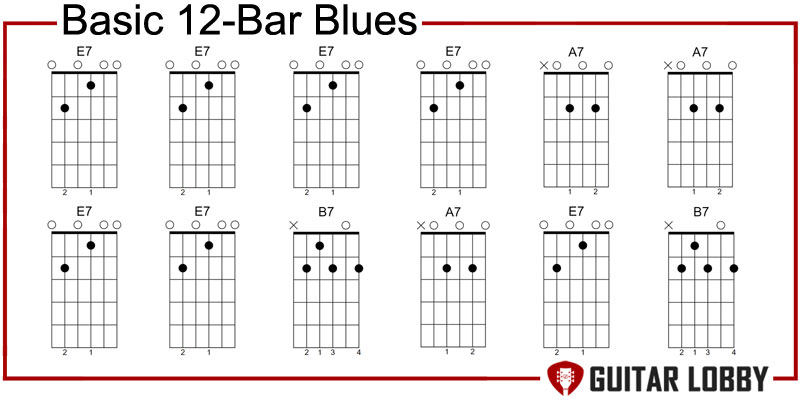
Traditional or modified, the 12-bar blues progressions are the heart and soul of blues music. There are other forms like 8-bar, 16-bar, and 24-bar, but the 12-bar blues is hands-down the most popular of the lot. It’s more than a chord progression as it not only tells you the order but also exactly how much time is spent on each chord. For the uninitiated, bars or measures is a unit of time with a specific number of beats. Since most blues songs are in 4/4 time signature, each bar in 12-bar blues lasts a count of four beats.
In its most simplified form, a 12-bar blues consists of I, IV, and V chords of a major key. There are 12 bar blues in minor keys, and I’ll be talking about them in a bit. Here’s what a basic 12-bar blues looks like:
| I | I | I | I |
| IV | IV | I | I |
| V | IV | I | V |
Now, apply this progression to the key of E major and use dominant 7th chords to add blues notes to the mix. You could turn any or all three chords into 7ths. If you decide to play only with the 7ths chords, the sequence you’ll be looking at will be:
| E7 | E7 | E7 | E7 |
| A7 | A7 | E7 | E7 |
| B7 | A7 | E7 | B7 |
An even more simplified form involves letting go of the V chord on the last bar and sticking to the I chord for the last two bars.
In blues, 12-bar progressions act as the structures on which songs are built. The progressions are repeated throughout, giving room for solos and vocals to shine. There are plenty of ways to embellish a standard 12-bar blues, like quick chord changes and jazzy turnarounds, to name a few.
Popular Songs That Use 12-Bar Blues: “Going Up the Country” (Canned Heat), “Hound Dog” (Elvis Presley), “Sweet Home Chicago” (Robert Johnson), “Pride and Joy” (Stevie Ray Vaughan).
6. Quick Change Blues and Elongated Dominant
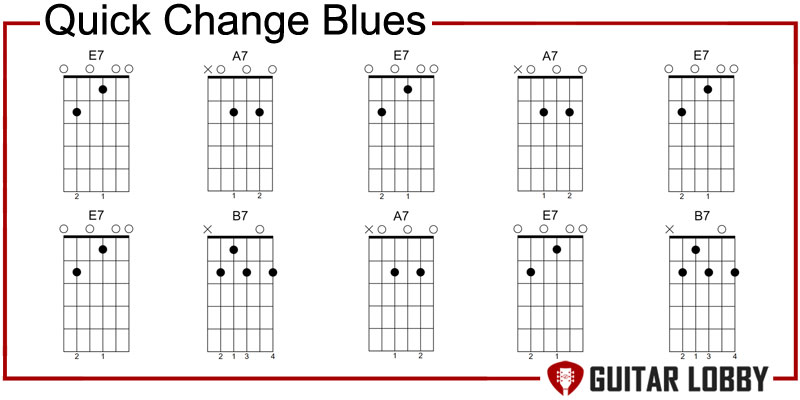
If you’re just getting started on your blues adventure, it’s a good idea to have a handful of basic 12-bar blues variations under your belt. In fact, simple changes, some of which involve changing a chord in one measure or another, could elevate the progression dramatically. After all, the last thing blues musicians want is their music to sound predictable, and tweaking chord progressions is a surefire way to do that. I’ll share two easy variations in this example.
Here’s one I particularly like:
| I | IV | I | I |
| IV | IV | I | I |
| V | IV | I | V |
Notice how the only change here over the previous example is IV or the subdominant replacing the I chord in the second bar. This is also called ‘quick change.’ Quick because it happens as early as the second bar of the first phrase. The sequence kicks off with the I chord changing swiftly to the IV chord before going back to the I chord for two more bars.
Another surefire tweak to spice up a vanilla progression is the use of ‘elongated dominant’ or long V. It’s nothing too fancy, just replacing the subdominant or IV chord in the 10th measure with a dominant or V chord. This way, you play the V chord for two consecutive measures in the third phrase. You can pair this trick by replacing the V chord in the last measure with the I chord. The progression with the long V chord is very common in uptempo blues rock tunes like Chuck Berry’s “Roll Over Beethoven.”
| I | I | I | I |
| IV | IV | I | I |
| V | V | I | I |
Popular Songs That Use Quick Change: “Sweet Home Chicago” (Robert Johnson), “Boot Hill” (Stevie Ray Vaughan), “Crossroads” (Cream).
Popular Songs That Use Elongated Dominant: “Folsom Prison Blues” (Johnny Cash), “Roll Over Beethoven” (Chuck Berry), “Rock and Roll” (Led Zeppelin).
7. 12-Bar Blues in Minor Key
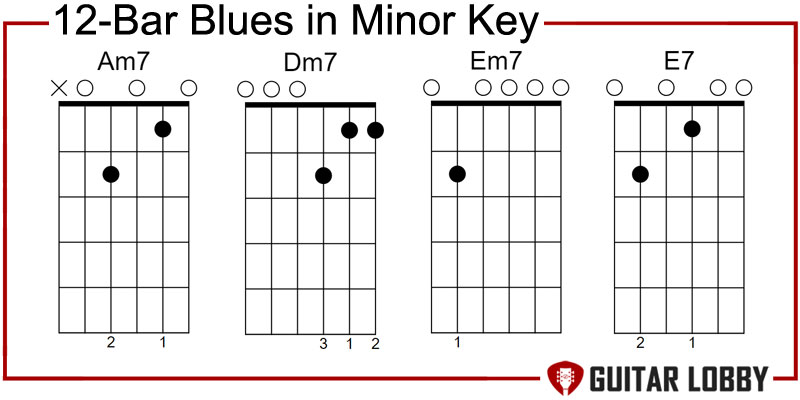
Like jazz, blues musicians make generous use of minor keys. As a result, all of the genre’s best-loved major-key progressions have a minor counterpart. This holds for 12-bar blues, where the i, iv, and v chords perform the same function as their major versions.
If we apply a basic minor blues progression to a minor key, say, A minor, our progression will be Am – Dm – Em chords or Am7 – Dm7 – Em7 if we use minor 7ths. However, in minor blues, the tonic and the subdominant chords are minor 7th chords. Meanwhile, the v chord stays a dominant 7th to keep the tension peaked before the resolution. The group of chords will become Am7, Dm7, and E7.
Starting on the tonic chord in a minor key makes the progression sound more mysterious and dark than major blues. Another example of 12-bar minor blues, this time in the key of C# minor, is the one in John Coltrane’s enduring hit “Equinox.”
The chords in C# minor key are:
i = C#m ii° = D# dim III = E iv = F#m v = G#m VI = A VII = B
The progression in “Equinox” is a modified 12-bar minor blues progression and looks something like this:
| i7 | i7 | i7 | i7 |
| iv7 | iv7 | i7 | i7 |
| bVI7 | V7 | i7 | i7 |
Looks pretty straightforward, except for maybe the appearance of the bVI7 chord in the 9th bar. The flat VI7 in the 9th bar transitions smoothly to the V7 in the 10th bar before resolving to i7. This bVI7 – V7 movement is very common in minor blues jazz standards.
Popular Songs That Use Minor Blues Progression: “Equinox” (John Coltrane), “Birks Works” (Dizzy Gillespie), “Long Train Running” (The Doobie Brothers), “Life is Hard” (Johnny Winter).
8. i7 – iv7 – v7
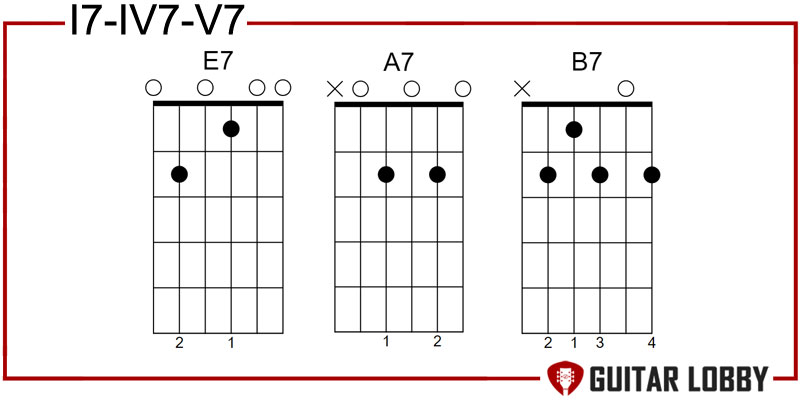
Yes, I did say that typically, in minor blues, the V7 chord replaces the v7. But there are, of course, some exceptions, like the blues standard “All Your Love.” This 1958 classic was written and recorded by Otis Rush, whose inventive guitar playing and long bent notes helped shape the sound of Chicago blues. The song has inspired many covers since its release, including one by John Mayall and Eric Clapton in 1966. And I want to zoom in on the chord progression used in their rendition.
Mayall and Clapton’s version is a standard 12-bar minor blues but sticks to the v7 chord instead of a dominant 7th. When played together, the i7, iv7, and v7 sound more somber than the i7, iv7, and V7 combination. The song begins as a 12-bar blues in the key of Am with Am7, Dm7, and Em7 chords. In the 3rd and 4th verses, it changes the key to A major and uses A7, D7, and E7.
Popular Songs That This Progression: “All Your Love” (John Mayall with Eric Clapton).
9. Blues Turnarounds
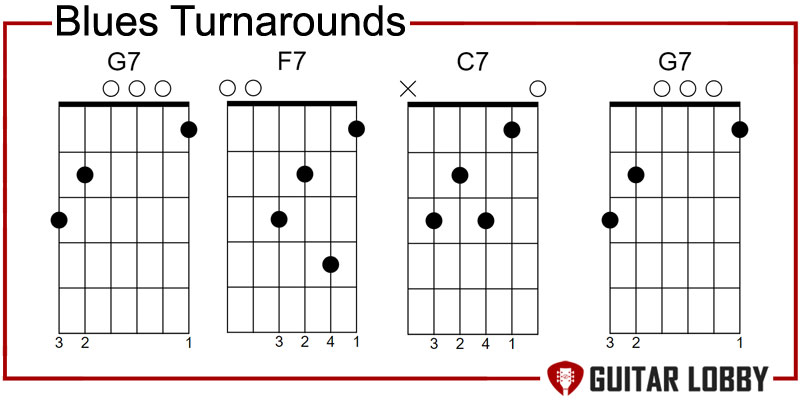
Turnarounds are progressions that usually show up in the last few bars of a blues sequence, regardless of whether it’s a 12-bar or 16-bar form. Having a turnaround works well in returning the listener’s ears to the tonic at the end of a section and prepping them for the sequence that will follow. In fact, the chords in the last four measures in 12-bar blues act as a chordal turnaround by taking listeners back to the beginning.
In a basic 12-bar blues, the last four bars are usually V – IV – I – V. In the key of C major, this would sequence would be G7 – F7 – C7 – G7. Notice how playing the G7 chord in the last bar creates a strong pull to the tonic chord.
However, if we take a leaf out of jazz books, then there are tons of turnarounds that can be worked into blues progressions. A commonly used turnaround in jazz is ii – V. You can apply this in 12-bar blues, making the last four measures look something like this: ii – V – I – V. Continuing our example of 12-bar blues in C, our last four measures would look something like this:
Dm7 – G7 – C7 – G7
The ii – V can also be used to replace the V chord in the last bar by playing the two chords in quick succession.
Whether you’re into rhythm or lead playing, you can count on turnarounds to spice up your blues jam. Another jazz-flavored turnaround worth checking out is the I – vi – ii – V or 1-6-2-5. You can play the four chords over the last two bars, with I and vi played in the 11th bar, and ii – V played in the 12th bar. In 12-bar blues in C, this would mean playing the following chords in the last four bars:
Dm7 – G7 – (C7 Am7) – (Dm7 G7).
Popular Songs That Use Blues Turnarounds: “Blues for Alice” (Charlie Parker),” “Honey Bee” (Stevie Ray Vaughan), “You Can’t Do That” (The Beatles), “Pride and Joy” (Stevie Ray Vaughan), “Tush” (ZZ Top).
Popular Related Article: Common Country Chord Progressions You Should Know
10. Jazz Blues
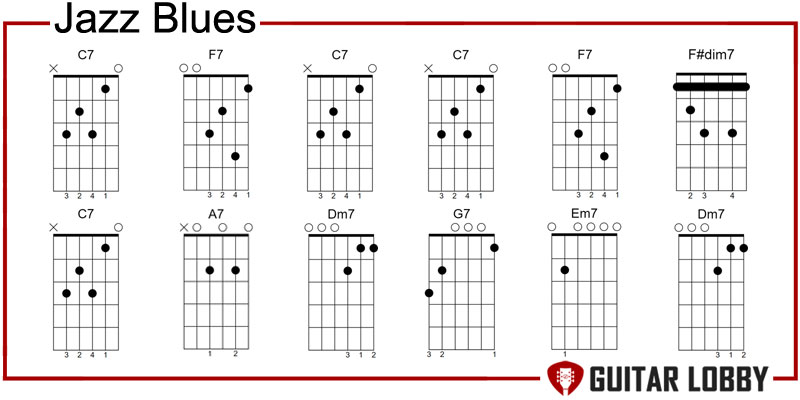
After exploring turnarounds in the previous example, it’s now time to talk about jazz blues. Jazz and blues are two genres connected by their love for blues notes, improvising, and syncopated rhythms. Unlike jazz, blues harmony makes good use of plagal motion, which is the movement of the IV or subdominant chord to the I or tonic chord. Jazz harmony, on the other hand, favors authentic cadences or V-I movement. By infusing 12-bar progressions with sequences like ii – V or vi – ii – V – I or a simple ii – V, you can add a jazzy spin to blues.
Another telltale sign of a jazz blues progression is the use of diminished chords in place of the IV chord in the 6th bar. You’ll also notice chords other than the usual I, IV, and V from the diatonic key. More often than not, these chords are the sixth and second chords in a key. The turnarounds that occur in the last couple of bars could range from a simple V chord to I – vi – ii – V or iii – vi – ii – V.
Let’s break this down using an example of 12-bar blues in C and applying the following jazz-tinged tweaks to it:
- vi – ii – V movement in 8th to 10th bar
- Using diminished chord in the 6th bar.
- Using turnarounds such as iii – vi – ii – V over the last two bars.
A typical 12-bar blues in C is as follows:
| C7 | F7 | C7 | C7 |
| F7 | F7 | C7 | C7 |
| G7 | F7 | C7 | G7 |
Applying the jazz tweaks would give us a jazz blues progression like the below:
| C7 | F7 | C7 | C7 |
| F7 | F#dim7 | C7 | A7 |
| Dm7 | G7 | Em7 A7 | Dm7 G7 |
Popular Songs That Use Blues Turnarounds: “Blues for Alice” (Charlie Parker),” “Honey Bee” (Stevie Ray Vaughan), “You Can’t Do That” (The Beatles), “Pride and Joy” (Stevie Ray Vaughan), “Tush” (ZZ Top).
11. Bird Changes
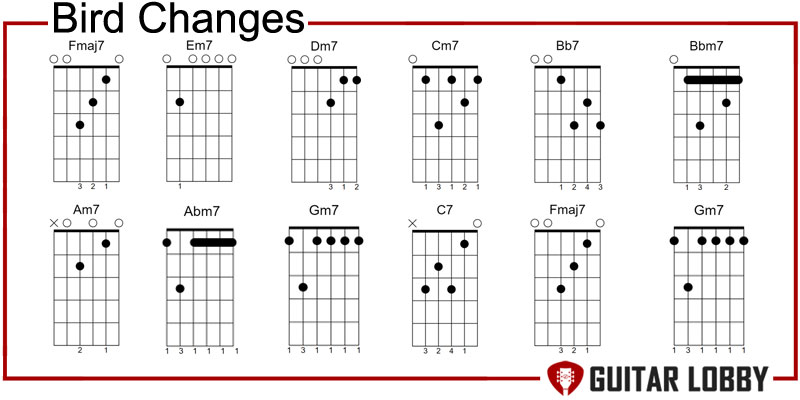
Learning the Bird Changes or Bird Blues will give you a solid grounding in using jazz-influenced sequences in 12-bar blues. This fascinating progression was named after virtuosic jazz saxophonist Charlie Parker, nicknamed ‘Bird’ by his fans for his love for all things chicken.
Parker first played the Bird Blues in his 1951 classic “Blues for Alice,” where he took a standard 12-bar blues and packed it with chord changes and ii-V sequential movements. The techniques employed by Parker were very common in the bebop – a very danceable style of jazz characterized by complex harmonies, fast chord changes, and syncopated rhythm.
The best way to describe bird changes in a blues context is a traditional 12-bar blues with small chord progressions between each target chord. The target or main chords in the progression are your standard blues chords: I7, IV7, and V7.
You start on the tonic chord, but instead of the usual movement to IV7 and, eventually, to the V chord, Parker made plenty of detours by using descending ii-V progressions and tritone substitutions of dominant chords. Another thing to note here is the I chord is not a dominant but a major 7th chord. Here’s what bird blues would look like in the key of F major:
| Fmaj7 | Em7 A7b9 | Dm7 G7 | Cm7 F7 |
| Bb7 | Bbm7 Eb7 | Am7 D7 | Abm7 Db7 |
| Gm7 | C7 | Fmaj7 D7b9 | Gm7 C7 |
Popular Songs That Use This Progression: “Blues for Alice” (Charlie Parker), “Confirmation” (Charlie Parker), “Bluesettle” (Toots Thielemans), “Freight Trane” (Tommy Flanagan).
12. 16-Bar Blues
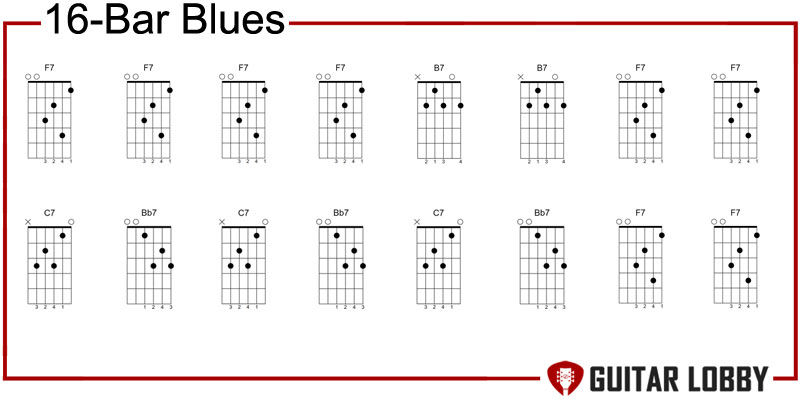
Although not as common as its 12-bar counterpart, the 16-bar blues is a must-know if you’re serious about adding iconic blues tunes to your repertoire. This is one of those blues chord progressions you simply must learn. All you’re doing here is extending a traditional 12-bar blues by adding four more bars. The additional bars can appear anywhere. In some songs like “I’m Your Hoochie Man” by Muddy Waters, the extra bars are employed to double the first line of bars. In Roman Numerals, this 16-bar form would look like this:
| I | I | I | I |
| I | I | I | I |
| IV | IV | I | I |
| V | V | I | I |
You could also see the four additional bars extending the second or third line. “Trigger Happy” by Al Yankovic and “Going Down the Road Feeling Bad” by Henry Whitter are examples of 16-bar blues where extended bars are repetitions of either the second or the third line instead of the first section.
Sometimes, the extensions aren’t as straightforward as repeating a line. In the 16-bar variation used in “Watermelon Man” by Herbie Hancock, we can hear the 9-10 bar or the movement of dominant to subdominant repeat twice. Here’s what it looks like in Roman numerals.
| F7 | F7 | F7 | F7 |
| B7 | B7 | F7 | F7 |
| C7 | Bb7 | C7 | Bb7 |
| C7 C7 Bb7 | Bb7 | F7 | F7 |
The movement from dominant (C7) to subdominant (Bb7) in the 9-10 bars also repeats in the 11-12 and 13-14 bars before resolving to the tonic (F7) chord. Besides extending the 12-bar blues, another variation of the 16-bar progression involves doubling an entire 8-bar blues. What is 8-bar blues? Find out in the next example.
Popular Songs That Use 16-Bar Blues Progression: “Going Down the Road Feeling Bad” (Henry Whitter), “Trigger Happy” (Weird Al), “Watermelon Man” (Herbie Hancock), “Oh Pretty Woman” (A.C. Williams).
13. 8-Bar Blues
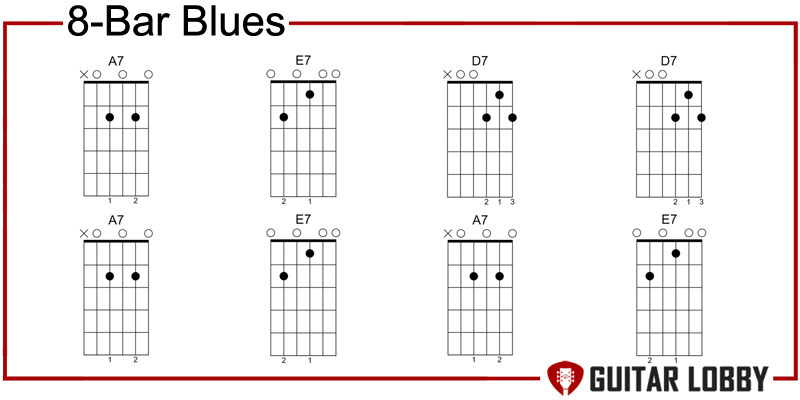
With a clue in the name, 8-bar blues is a common blues progression made up of the very same I, IV, and V chords but spread over eight measures instead of twelve. It’s also easier to play around with and adapt as compared to its 12-bar cousin. Here’s what a typical 8-bar blues looks like in Roman numerals:
| I | I | IV | IV |
| I | V | I-IV | I-V |
Notice how the movement from tonic to subdominant happens much quicker in bar 3. In a 12-bar, this usually occurs in the bar 5. An example of this version of the 8-bar blues can be sampled in “Worried Life Blues” by Big Maceo.
In Key to the Highway, a blues standard with countless recordings, you can hear a variation in bar 2 with the V chord instead of the I chord.
| I7 | V7 | IV7 | IV7 |
| I7 | V7 | I7 | V7 |
This iconic tune is in the key of A major. So that makes our tonic, subdominant, and dominant chords – A, D, and E, respectively. Don’t forget to add 7ths to make them bluesy, and the progression you’ll end up with will be as follows:
| A7 | E7 | D7 | D7 |
| A7 | E7 | A7 | E7 |
Popular Songs That Use 16-Bar Blues Progression: “Key to the Highway” (Big Bill Broonzy), “How Long Blues” (Leroy Carr), “Trouble in Mind” (Chippie Hill), “It Hurts Me Too” (Tampa Red).
14. I – bVII – bVI – V
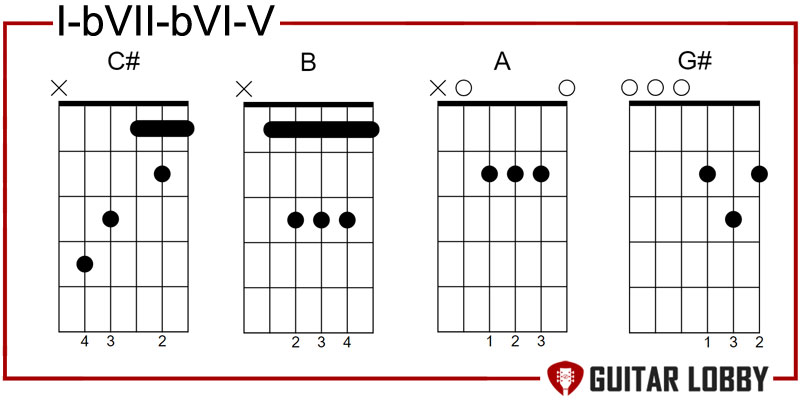
Sometimes, diatonic chords are not enough, and there’s something extra needed to make a tune memorable. So, what do blues songwriters typically do? They go ahead and borrow chords from related scales. Take any major key, say C# major. The chords that naturally belong to this key are:
I = C# ii = D#m iii = E#m IV = F# V = G# vi = A#m vii⁰ = B#dim
Instead of limiting their chord library to I, IV, and V chords, many blues musicians lift chords from other scales, such as the parallel minor key, which is based on the same tonic. In this case, it would be C# minor.
i = C#m ii° = D#dim bIII = E iv = F#m v = G#m bVI = A bVII = B
There are three chords that are particularly favored when composing blues rock tunes: the bVII and bVI chords. Since they come from a minor key, these chords help in adding a mysterious, darker quality to the song. The bVII7 brings with it a distinctive blues-meets-hard rock vibe. The same applies to the bVI chord.
J.J. Cale’s “Cocaine” is a fantastic example of chord sequences made up of these non-diatonic chords. He plays in the key of C# using the I – bVII progression in the verses and a descending I – bVII – bVI – V sequence in the chorus. We’ve already seen the chords in the key of C# and its parallel minor key C#m. So here’s what these progressions look like when applied to the song’s key.
C# – B – C# (Verses)
C# – B – A – G# (Chorus).
Popular Songs That Use 16-Bar Blues Progression: “Cocaine” (J.J. Cale), “I’m Cryin” (The Animals).
Popular Related Article: Most Common Jazz Chord Progressions
15. I9 – IV9 – V9
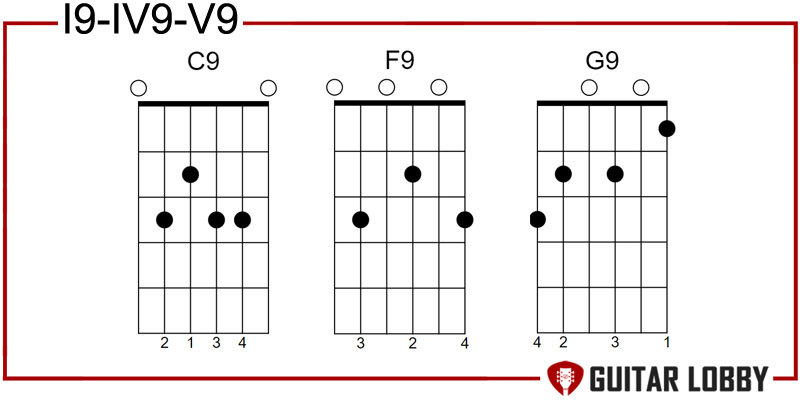
The I9 – IV9 – V9 is your typical blues sequence, except it uses dominant 9th chords instead of the more common dominant 7th chords. More often than not, you’ll find the 9th chords in slower, more laid-back blues. How is a dominant ninth chord different from a dominant 7th chord? The answer lies in the notes. A dominant 7th contains the root, 3rd, 5th, and flattened 7th notes. Meanwhile, a dominant 9th contains all the notes of a dominant 7th and adds a major 9th to it.
A dominant 9th shouldn’t be confused with a major 9th. Let me elaborate: In the key of C, a major ninth chord like Cmaj9 would consist of a C major triad with an added major 7th and a major 9th. It’ll have the following notes: Cmaj9 = C, E, G, B, and D. A C9 or a dominant 9th chord would contain a minor (flattened) 7th instead. So, the notes would be C, E, G, Bb, and D.
You can add character and spice up a vanilla 12-bar blues by simply replacing dominant 7th chords with dominant 9th ones. American singer-songwriter and a well-known name in modern blues, John Mayer, favors 6th and 9th chord voicings in his tunes. A I9 – IV9 – V9 progression can.be heard in his rendition of the blues standard “Everyday I Have the Blues.” The song is usually played with dominant 7ths, but Mayer swaps them with 9ths and uses the C9 – F9 – G9 progression throughout.
Popular Songs That Use This Progression: “Everyday I Have the Blues” (John Mayer).
Conclusion:
As a genre that goes back all the way to the late 1800s, blues has influenced several musical movements, from jazz to rock and roll. Blues progressions can be heard in virtually every genre, including heavy metal! Therefore, learning some of the chord sequences we explored here will help you diversify your repertoire with past and contemporary classics from across musical styles.

My name is Chris and I’ve had a passion for music and guitars for as long as I can remember. I started this website with some of my friends who are musicians, music teachers, gear heads, and music enthusiasts so we could provide high-quality guitar and music-related content.
I’ve been playing guitar since I was 13 years old and am an avid collector. Amps, pedals, guitars, bass, drums, microphones, studio, and recording gear, I love it all.
I was born and raised in Western Pennsylvania. My background is in Electrical Engineering, earning a Bachelor’s degree from Youngstown State University. With my engineering experience, I’ve developed as a designer of guitar amplifiers and effects. A true passion of mine, I’ve designed, built, and repaired a wide range of guitar amps and electronics. Here at the Guitar Lobby, our aim is to share our passion for Music and gear with the rest of the music community.
